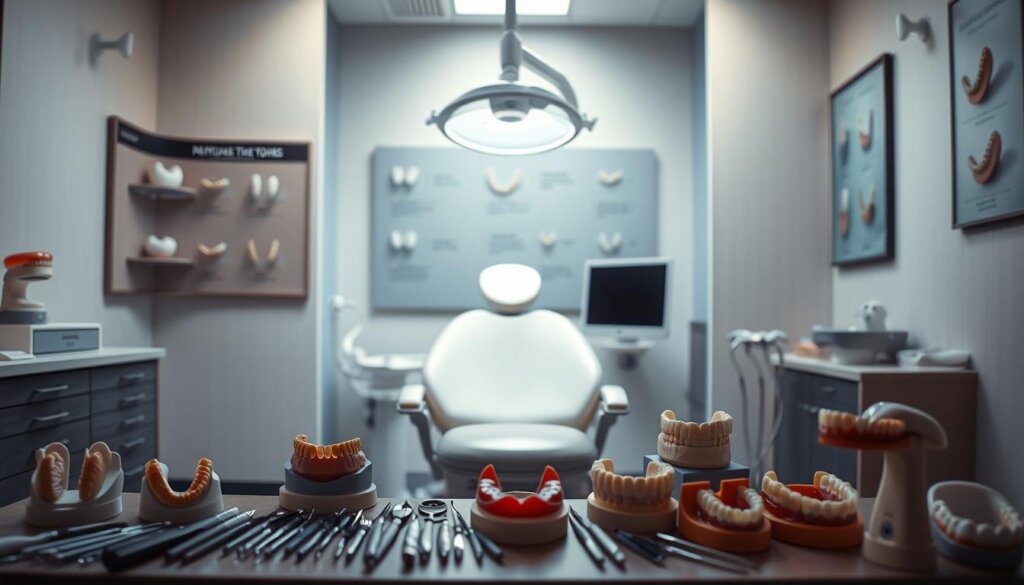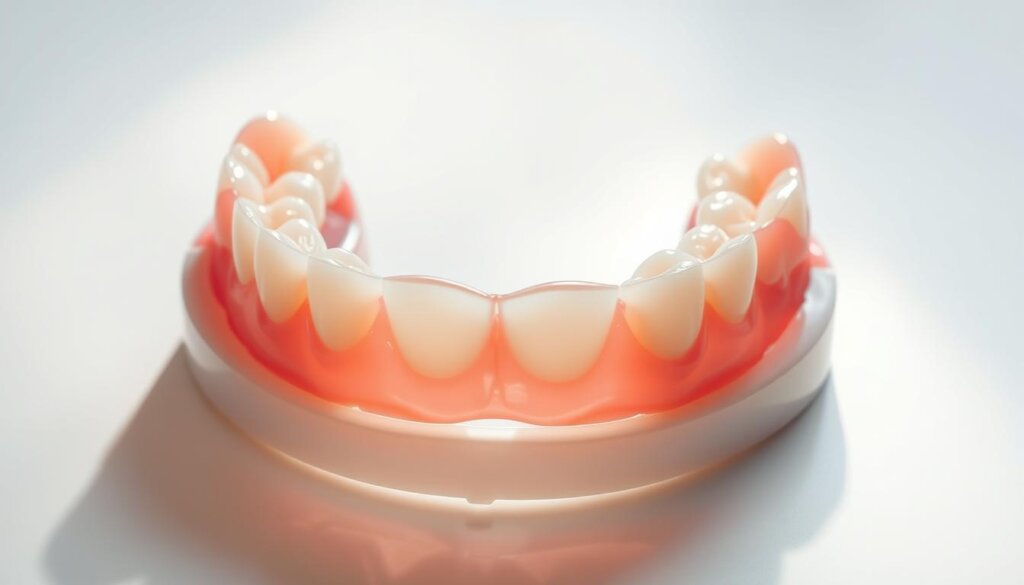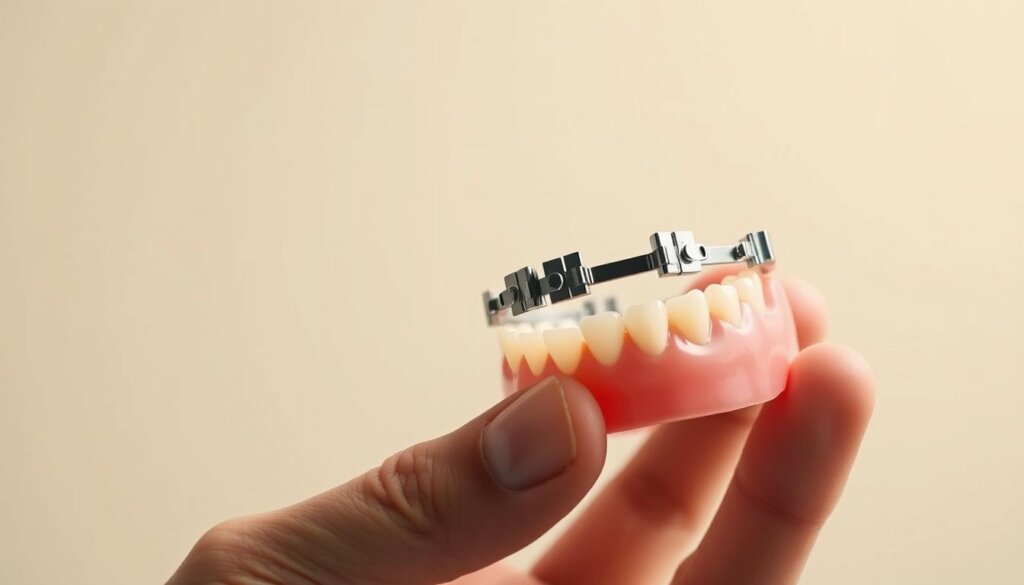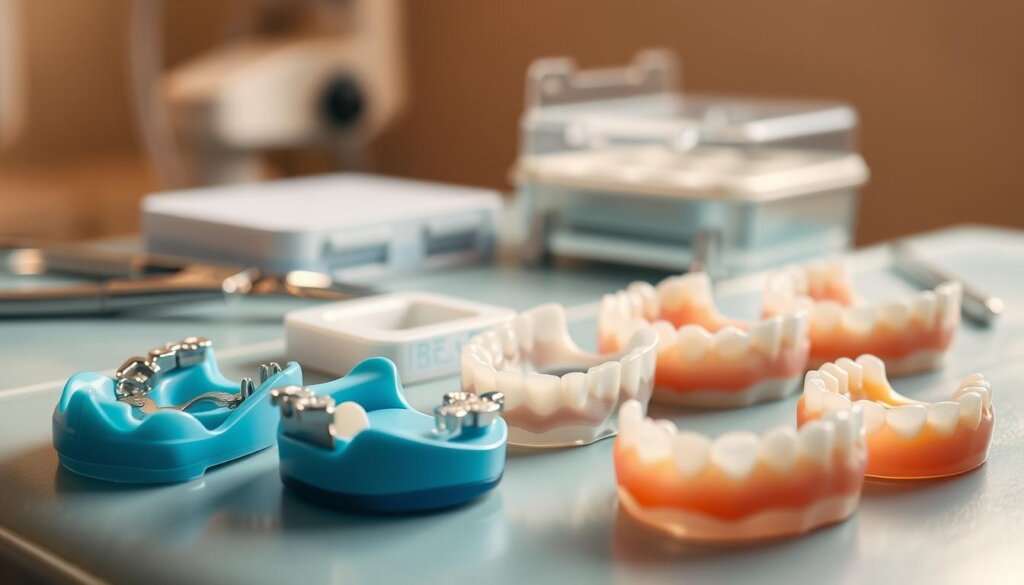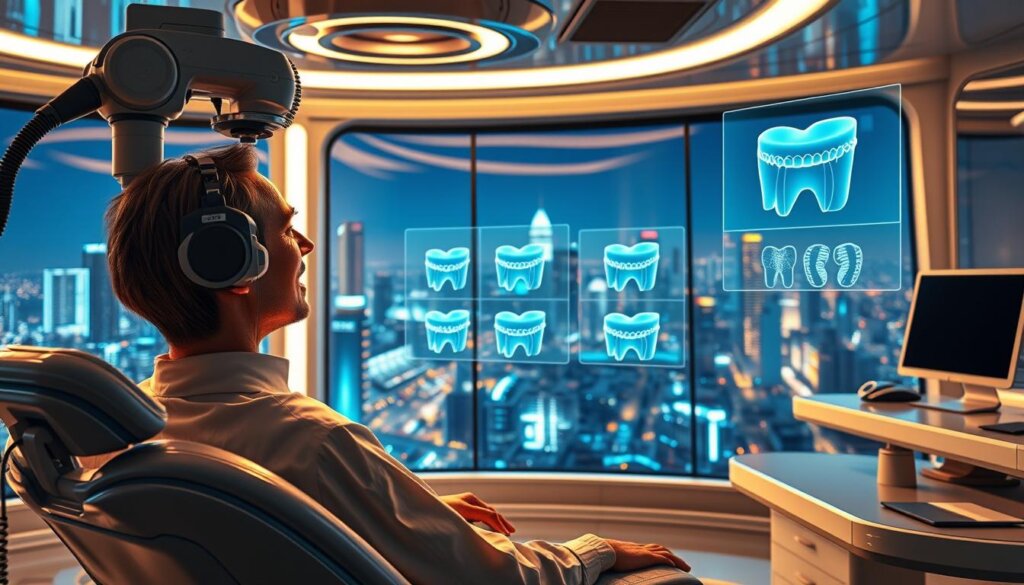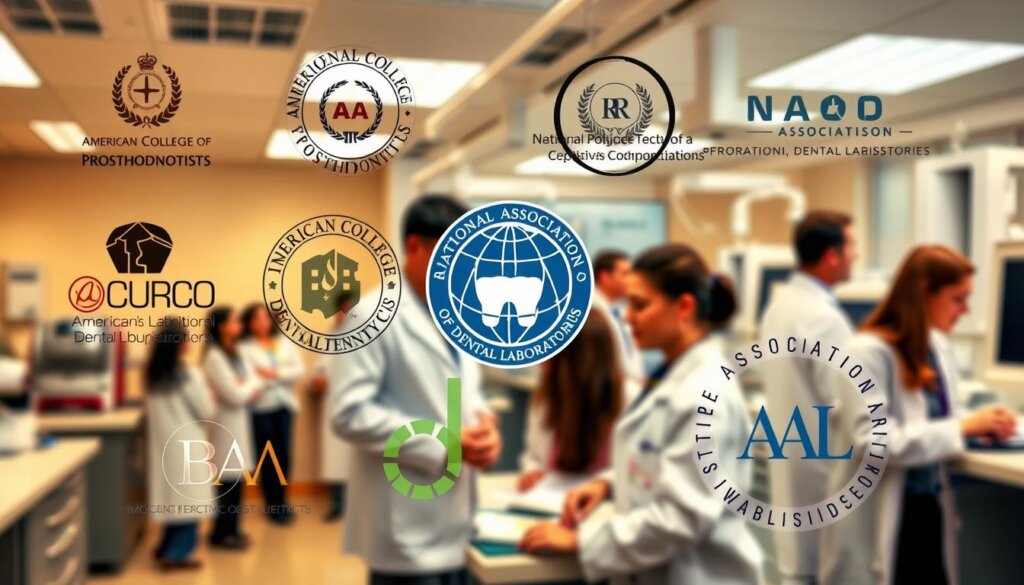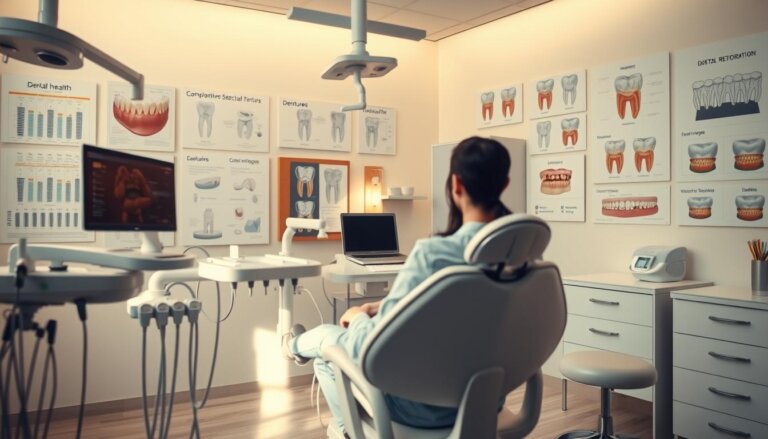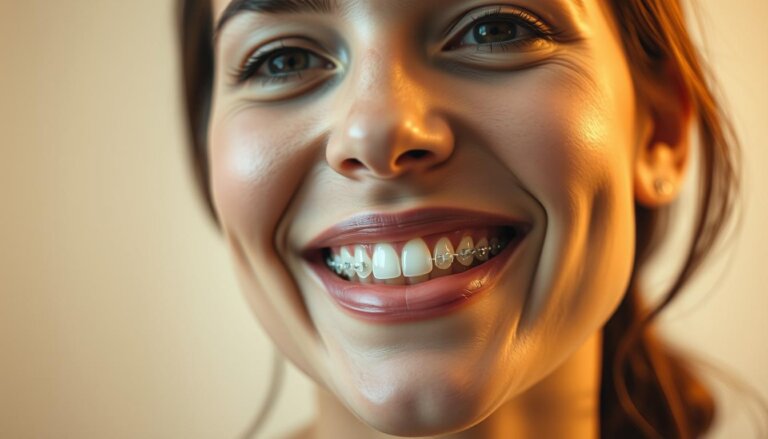Should I Consider a Removable Partial Denture for One Missing Tooth?
In the United States, a surprising 120 million people are missing at least one tooth. This leaves many wondering how to best fill this gap. Removable partial dentures (RPDs) are one option that comes up often. People ask if an RPD is a good choice for just one missing tooth. This is especially important when considering how easy RPDs are to get compared to other, more invasive and expensive options.
Dental experts often suggest removable partial dentures as a temporary solution. They work well while waiting for permanent options like implants or bridges. But it’s important to know that they’re not as solid or long-lasting as other choices. Still, RPDs can be a quick, affordable fix, particularly after an unexpected loss or when health issues cause a tooth to fall out. Getting advice from a dentist who knows a lot about removable dental appliances is crucial. They can help avoid problems from a bad fit or wrong use.
Key Takeaways
- 120 million Americans face the challenge of single-tooth loss, reflecting the broad relevance of RPDs.
- A removable partial denture can provide a swift, budget-friendly solution for tooth replacement.
- Evaluation by a dentist is crucial in determining suitability for removable dental appliances.
- Removable partial dentures are usually less stable than options like implants or bridges, but offer immediacy.
- RPDs can be a significant step in ensuring oral health and aesthetics post-tooth loss.
- When asking “Should I consider a removable partial denture for one missing tooth?”, one should balance immediate needs with long-term oral health goals.
Understanding Removable Partial Dentures
A removable partial denture helps people who are missing a few teeth. It fits into the broader family of dentures, providing significant help in dental health and looks. They are built with a metal frame that attaches to your natural teeth, and they may have plastic bases for fake teeth.
These dentures improve how you look and work by filling empty spaces left by lost teeth. This stops other teeth from moving out of place. There are two main types, each suited to different needs for stability, comfort, and health.
Definition of Removable Partial Dentures
Removable partial dentures have fake teeth on a pink or gum-colored base, sometimes connected with a metal frame. They are easy to use and offer good benefits. These don’t require making permanent changes to teeth nearby.
How They Work in Dentistry
Removable partial dentures are key in dental prosthetics for better chewing and speaking. They hook onto existing teeth with clasps and rests. This holds them in place, using the remaining teeth’s strength. It helps to spread out the force when chewing, preventing more dental problems.
This feature not only looks good but also fits well into daily life. It’s easy to adjust or take out for cleaning. This shows the practical advantages of using them every day.
Benefits of Removable Partial Dentures
Removable partial dentures offer a big benefit for those missing teeth. They not only look good but also help you eat better. These dentures are easy to use and can really help improve your life if you’re missing one or more teeth.
Some top benefits include:
- Improved Aesthetic Appeal: They look like your real teeth and mix well with the teeth you still have. This helps give you a full, natural-looking smile again.
- Enhanced Chewing Functionality: These dentures spread out the chewing forces over a larger area. This helps make eating easier and digestion better.
- Support for Surrounding Teeth: By filling in the gaps, these dentures keep your other teeth from moving out of place. This keeps your teeth aligned and healthy.
See the table below for how removable partial dentures can help:
| Aspect | Benefit |
|---|---|
| Aesthetic Improvement | They match your natural teeth, making your smile look better and boosting your confidence. |
| Chewing Efficiency | They help spread your bite more evenly, which means better digestion. |
| Support to Adjacent Teeth | They keep the teeth next to the gap from moving, so your teeth stay straight. |
While these dentures are a great choice for missing teeth, it’s important to get them checked and fitted by a dentist regularly. This makes sure they work well and are comfortable, without hurting your looks or oral health.
Drawbacks of Removable Partial Dentures
Removable partial dentures are an option for those missing teeth. But, they have challenges that may affect their success and how happy patients are with them. It’s important for patients to know these drawbacks when thinking about getting them.
Comfort and Fit Concerns
Getting used to a removable partial denture can be uncomfortable at first. It might feel tight or cause some soreness. This happens as your mouth adjusts to keeping the denture in place.
If the denture doesn’t fit just right, this discomfort might keep happening. That’s why going for regular check-ups and getting it adjusted is key.
Maintenance and Cleaning Requirements
To keep removable partial dentures working well and lasting long, they need careful cleaning. You have to clean them regularly to stop gum disease and keep your natural teeth healthy.
Taking care of dentures also means being gentle with their delicate parts. This care can take a lot of time and may bother some people.
Potential Tooth Mobility
A big worry with long-term use of removable partial dentures is they might make nearby teeth loose. The pressure from the denture can cause these teeth to move. This could lead to more dental problems.
A good fit and check-ups by a dentist can lower this risk.
The cost of removable partial dentures needs to be thought about carefully because of these issues. They are usually less expensive than other options. But, costs might go up if you need many adjustments or new ones.
In the end, when thinking about ways to replace teeth, these factors should be seriously considered. Talking to a dentist can help you make a choice that fits your needs and life best.
Factors to Consider Before Choosing a RPD
Thinking about getting a removable partial denture for one missing tooth? It’s important to think about several key things. These include how healthy your mouth is, the costs, and how it fits with your life.
Overall Oral Health
Your mouth’s health is very important when considering a removable partial denture. You need healthy gums and strong teeth next to where the denture will go. A dentist will check if your mouth can handle a new denture without problems.
Cost Considerations
- Initial Investment: Look into how much different dental prosthetics cost upfront.
- Long-term Value: Think about how long the denture will last compared to its price.
- Insurance Coverage: Find out what your dental insurance pays for and your out-of-pocket costs.
Lifestyle Factors
- Dietary Preferences: Think about if you need to change your diet for the denture.
- Maintenance Commitment: Are you ready to clean the denture daily and see the dentist often?
- Social and Physical Activity Levels: Think about if the denture will change how you talk or do things.
Choosing the right removable partial denture for one missing tooth needs you to look at many things. By carefully thinking about each part, you can make the best choice. You’ll balance looking and feeling better with your health and money.
Alternative Options to Replace a Missing Tooth
Removable partial dentures are a common choice for missing teeth. But, there are other options too. Dental implants, fixed bridges, and flipper dentures are among the popular ones. Each choice has its own benefits and challenges. It’s important to think about these carefully, considering what’s best for the person’s dental health.
Dental Implants are known for being tough and not harming neighboring teeth. They go right into the jawbone, offering a firm support for fake teeth, much like real tooth roots do. Yet, they cost more and need good bone density to work.
Fixed Bridges fill the space left by missing teeth. They use artificial teeth attached to teeth or implants nearby. This method is quicker and less harsh than dental implants. But, it does change the teeth next to the gap, which might not be what some want.
For a quick and less costly fix, Temporary Solutions like flipper dentures are a good pick. These are easy to make and cheap but they’re not as firm as implants or bridges. They’re best for short use, waiting for a lasting solution.
Knowing all the dental prosthetic options is key to choose right for missing teeth. Speaking with a dental expert can help decide based on personal needs. This ensures the chosen treatment works well and looks good, too.
Who is a Good Candidate for RPDs?
Thinking about a removable partial denture for one missing tooth? It’s important to know who really benefits from these. Removable partial dentures (RPDs) work best for certain people with particular dental needs and health conditions.
Age is a big factor when thinking about RPDs. While anyone can consider them, how old you are greatly affects if they’re right for you. Younger and older folks might find that RPDs fit their dental health in different ways. This is because of the health and strength of their teeth and gums.
Good oral health is key for those considering RPDs. You’ll need:
- Strong teeth left to support the RPDs
- Healthy gums, not suffering from severe gum disease
- Enough bone support for the dental device
These are crucial because RPDs need to sit comfortably and work well. Only if your mouth’s overall condition is up to par. Dentists do thorough checks to see if RPDs are a good fit for you.
In short, RPDs are an option for filling in that gap from a missing tooth. But they’re not for everyone. Only those who meet certain age and health standards. Always get a full dental check-up to see if RPDs are right for your smile.
The Process of Getting a Removable Partial Denture
Starting your journey to a full smile with tooth replacement options like dental prosthetics isn’t just about tech. It’s about making sure your unique needs are fully met.
At the first meeting, dentists do a deep check-up. This is to see if removable partial dentures fit you best, looking at your oral health, teeth structure, and what you prefer. It’s key in tailoring dental prosthetics just for you.
Next, they take detailed impressions of your mouth. These impressions are crucial. They are the guide for making the denture that will fit you perfectly. The better the impression, the more comfortable and useful the final denture will be.
After making the denture, it’s time to fit it and make any needed adjustments. Patients see their dentists for the first fitting of their new dentures. Often, some tweaks are needed to get the perfect fit and comfort. This might mean going back a few times.
During these visits, your dentist will fine-tune the fit of your denture. This is to make sure there’s no discomfort. They aim to make eating and talking feel normal again.
Knowing all these steps can make people feel more at ease about getting dental prosthetics. It shows the care and custom work that goes into creating effective tooth replacement options.
Maintenance Tips for Removable Partial Dentures
For those with missing teeth, keeping removable partial dentures (RPDs) in top shape is key. A careful cleaning routine helps keep the dentures and your mouth healthy. In this article, we’ll cover the best daily habits and why seeing your dentist regularly matters.
Daily cleaning routines are crucial for denture care. They help get rid of food bits and lessen plaque, preventing damage or infection. Use a soft brush and a gentle cleaner made for dentures. Stick to this routine to keep your dentures looking and working well.
Also, visiting your dentist often is vital for denture maintenance. These check-ups let dentists check how your dentures fit and adjust them if needed. These visits prevent discomfort and help your dentures do their job right.
| Maintenance Activity | Frequency | Purpose |
|---|---|---|
| Cleaning with soft-bristled brush | Daily | Removes food debris and prevents plaque buildup |
| Use of non-abrasive cleaner | Daily | Protects denture material, maintains hygiene |
| Dental check-up | Every 6 months | Ensures proper fit and function of dentures |
Proper care of your removable dentures is essential, not just for their function but also for your confidence and comfort. By following these tips every day, you can make sure your denture solution for missing teeth stays effective.
Common Questions About RPDs
For many seeking solutions for a missing tooth, removable partial dentures (RPDs) are a great choice. They mix functionality, looks, and affordability well. With dental prosthetics, patients often wonder about their durability, effect on other teeth, and how long they’ll last.
How Long Do They Last?
Removable partial dentures are key for treating missing teeth. Their lifespan varies, depending on care and materials used. Usually, an RPD can last five to ten years. With good care and dentist visits for adjustments, they can last even longer.
Can They Damage Natural Teeth?
RPDs are made to be safe and effective. Yet, they can sometimes harm natural teeth. The metal clasps that hold the dentures can pressure teeth, causing wear or damage. It’s important to talk with a dentist about how to protect your teeth.
Many worry about the removable partial denture cost and how well they work. Talking with a dentist can give you the specific info you need. This helps make the best decision for your dental care.
Real Patient Experiences with RPDs
Looking into how patients feel about removable partial dentures (RPDs) shows us the different results they get. We learn about the good things and the hard parts of using RPDs from them. This helps anyone thinking about getting partial denture options for missing teeth.
Many people find their teeth work better and their smiles look nicer with RPDs. They talk about how good it is to chew well again and to have a nice smile. But, getting used to RPDs can be tough at first. People often mention how it feels weird and might hurt a bit in the beginning.
- Success Stories: After the tough start, many patients are happy. They’re glad to have their full smile back and better mouth function.
- Challenges Faced: Early on, some have trouble with how the RPDs fit and feel. They say it’s key to keep talking to their dentist for fixes.
Patient stories teach us a lot about using RPDs. They show the importance of a great fit and making changes as needed. Also, they remind us to keep our teeth clean and visit the dentist to make sure RPDs last a long time and work well.
Cost of Removable Partial Dentures vs. Alternatives
When looking at ways to replace teeth, knowing the costs is key. Removable partial dentures (RPDs) often offer a more affordable option than others. In the next sections, we’ll look at the costs of RPDs, insurance coverage, and how they stack up against other methods.
Average Price Range for RPDs
RPDs can vary in cost, depending on the materials used and the complexity of the patient’s dental needs. Prices usually range from $650 to $2,500 each. This makes RPDs a solid choice for those needing a less invasive option.
Insurance Coverage Insights
Insurance can help cut the costs of RPDs, making them a reachable goal for many. A lot of dental plans cover part of the cost. But, coverage can differ by plan. Checking with your insurance is a smart move to figure out what they will pay for.
Table: Comparative Costs of Tooth Replacement Options
| Replacement Option | Average Cost | Insurance Coverage | Longevity |
|---|---|---|---|
| Removable Partial Dentures | $650 – $2,500 | Partial | 5-15 years |
| Dental Implants | $3,000 – $4,500 | Limited | Up to 25 years |
| Fixed Bridges | $2,000 – $5,000 | Partial | 10-20 years |
The table above shows RPDs might need more upkeep or replacement sooner than other choices. However, their lower starting price and potential insurance help make them a budget-friendly choice for many looking for dental prosthetics.
Preparing for Your New Removable Partial Denture
Getting used to removable dental appliances, like partial dentures, is a big change. It needs patience and practice. It’s not just about looking better. It’s getting used to something new in your life. Here are some tips for getting used to your RPD and what to eat at first.
Adjusting to Wearing an RPD
At the start, it might feel weird or uncomfortable to wear a new dental appliance. Here are some tips to make adjusting easier:
- Practice inserting and removing the denture to become comfortable with its handling.
- Spend time each day speaking aloud to adjust to the feel of the denture in your mouth, which will improve your clarity in speech over time.
- Begin with wearing your dental prosthetics for a few hours each day, gradually increasing the duration until it feels natural.
Foods to Avoid Initially
In the beginning, it’s good to avoid certain foods to protect your new RPD. Certain foods might be hard to eat or could harm your denture:
- Hard foods: such as raw vegetables and nuts, might risk dislodging or damaging the denture.
- Sticky foods: such as caramel or taffy, can adhere to the dentures, making them difficult to clean.
- Chewy meats: might offer resistance, making them tough to bite or chew comfortably.
Following these food tips helps keep your new dental appliance safe. It also makes adjusting to your RPD more comfortable.
Future of Removable Partial Dentures
In the field of dental prosthetics, removable partial dentures (RPDs) are changing to match today’s needs. New designs and materials aim to set new standards for tooth replacement options. As these innovations come into play, you might think: Should I consider a removable partial denture for one missing tooth? Let’s dig into the expected advancements.
RPDs are moving beyond old-school metal-acrylic mixes towards cutting-edge materials for better looks and feel. A big step forward is using thermoplastic materials that are bendy and don’t contain metal. These changes are designed to offer:
- Better looks with clear and adaptable materials that look just like real teeth.
- More comfort thanks to their light and flexible nature.
- Stronger durability that lasts through everyday wear while keeping the denture in great shape.
Potential Changes in Patient Preference
As dental tech improves, people are leaning towards these new RPDs. They prefer them for a few reasons:
- They want replacements that look more like natural teeth.
- They’re looking for options that don’t need surgery, unlike dental implants.
- They’re more aware of dental advancements, which helps them make better choices for their oral health.
The future looks bright for removable partial dentures. With better materials and designs that focus on the patient, RPDs are becoming a top choice for those looking to replace missing teeth in a way that looks good and feels right.
Professional Associations and Resources
Professional groups focused on dental prosthetics are vital for the field’s growth. They offer key support and resources for both doctors and patients. These groups aim to enhance knowledge and use of various tooth replacement options, like the favored removable partial denture benefits. Thanks to their work, dental care providers can give the top care to those needing restorative treatments.
One major role of these associations is creating and sharing educational content. This info helps patients get the lowdown on dental prosthetics and why removable partial dentures are a good pick. For dentists, staying up-to-date with new methods and research on tooth replacement options is crucial. It helps them better their practices and the way they care for patients.
Moreover, these groups provide chances for networking, as well as attending conferences and seminars. These events let professionals exchange ideas and stories about dental prosthetics. Such sharing leads to a wider grasp of removable partial denture benefits. It also promotes the use of the best methods throughout the field.
Conclusion: Is an RPD Right for You?
As we wrap up, the key question stands: Should I consider a removable partial denture for one missing tooth? Choosing the right treatment for a missing tooth is a big deal. It’s not just about how it looks or works right now, but also how it affects your oral health later. Dental prosthetics, like RPDs, offer a less invasive and cheaper way. Still, they have their own needs and limits.
There are more things to think about than just fixing a missing tooth. We need to look at how long the solution lasts, how it affects the teeth nearby, and what each person’s daily life is like. We must pay close attention to these details with a clear understanding. Combining medical facts with personal needs helps make a choice that is smart and feels right.
Talking to your dentist is a crucial step in deciding. With their expert advice and a full check-up of your oral health, you can see if RPDs fit your situation. Your dentist knows a lot about replacing teeth and can help you weigh your options. By working together, you can make a choice that’s good for your smile and for your overall oral health.

